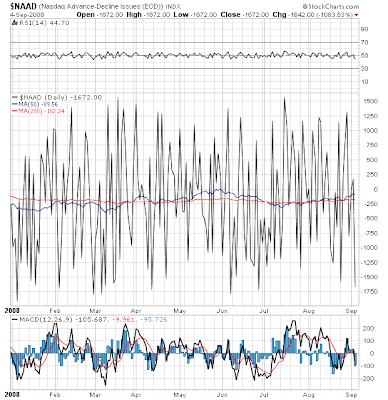Supporting the case I made yesterday suggesting the market's present weakness is reminiscent of early-April '08 (i.e. midway through the March 17th - May 19th bounce) are the NYSE and NASDAQ McClellan Oscillators. Both are holding up quite well ... and this is despite today's throttling whose impact saw the widest differential between advancing and declining issues registering on both exchanges since late-June.


Clearly, one must conclude bottom to the present decline will coincide with an Advance-Decline divergence (see the March 17th and July 15th bottoms, for example). So, there's probably more selling still to come over the days ahead. Bottom should see the Advance-Decline differential on both exchanges improve upon today's weak readings.
Likewise, relative strength in the NYSE and NASDAQ McClellan Oscillators indicates bottom might be nearer than the broken spirits of CNBC's cheerleaders otherwise leads one to think. Here, then, is what to look for...


First, we need to see a bounce bringing RSI above peak readings on Wednesday. Then, a decline taking both Composite Indexes to a new low, while in the meantime RSI diverges (i.e. fails to register a reading lower than today's). This should mark bottom.
Subsequently, expect the post-July 15th bounce to resume ... and for the volume of shares exchanged to return to its deer in the headlights, death warmed over ways.
Whether an anticipated advance above the August 11, 2008 peak might complete the post-July 15th bounce remains to be seen. We have the mid-April through mid-May '08 rally to new heights, post-March 17th bottom, standing as a template of sorts, and so, highlighting the possibility the precipice from which the market suffers a nasty spill might then be at hand...

* * * * *
© The Risk Averse Alert — Advocating a patient, disciplined approach to stock market investing. Overriding objective is limiting financial risk. Minimizing investment capital loss is a priority.
Analysis centers on the stock market's path of least resistance. Long-term, this drives a simple strategy for safely investing a 401(k) for maximum profit. Intermediate-term, investing with stock index tracking-ETFs (both their long and short varieties) is advanced. Short-term, stock index options occasionally offer extraordinary profit opportunities when the stock market is moving along its projected path.
Nothing is set in stone. Nor is the stock market's path of least resistance always known. More often than not, there are no stock index option positions recommended.
 There's an easy way to boost your investment discipline...
There's an easy way to boost your investment discipline...Get Real-Time Trade Notification!



















